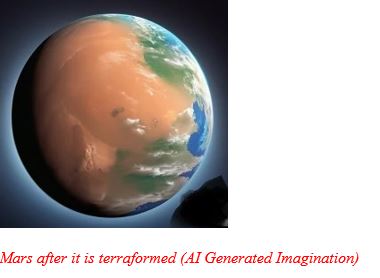Mars and its Terraforming: A New Frontier?
Mars, the red planet, stands at the forefront of human extra-terrestrial vision. The contemplation of augmenting humanity’s reach beyond the planet earth is simply intriguing and may be an inevitable feat in the coming decades. Among all the research and scientific explorations to the red planet, the prospect of colonizing the planet is probably the most ambitious venture. However, the hostile environment on the planet calls for extreme innovations in biological arena, engineering applications and of course, a quantum jump in the planetary science & Space travel details.
The answer is Mars Terraforming, a monumental scientific challenge, to transform the cold & dead planet into one capable of supporting human life. But the rise in planetary science & evolution of technology, the idea of terraforming Mars may no longer be a challenge or merely a science fiction, but a long-term aim to commence habitation beyond earth.
What is Terraforming of a Planet?
Terraforming means a deliberate alteration of the environment of a planet to make it habitable for human life or other life forms. It involves a set of activities that help in modifying the atmosphere, temperature, pressure & other associated parameters integral to an ecosystem that enables habitation of human or any other life form. In short, make the planet “earth like”.


Phoenix Found Ice Below Martian Surface Soil in 2008. Photo Source: JPL-NASA
How Mars will Warm Up?
- Nuclear Explosions above Mars Polar Cap- It will melt the water ice and spread it over the planet. The heat will vaporize the frozen CO2 & this greenhouse gas will assist in heating up the planet. The released CO2 will add into the atmosphere and double the atmospheric pressure.
- Redirecting multiple massive comets & asteroids to Mars surface, which will penetrate Mars surface, causing underground explosion & heat distribution, and unlock the tightly bonded carbon and CO2 locked in deep Martial soil. This will help to warm the planet & increase atmospheric pressure. It will also melt ice underneath Mars surface.
- Artificially release Green House Gases & Heat trapping gases into Mars atmosphere. These gases should be superior to CO2, like CFC (Chlorofluro Crabon)
- Future Excavations on Mars Surface to release the underground CO2 & melt the subsurface Ice.
“Our results suggest that there is not enough CO2 remaining on Mars to provide significant greenhouse warming were the gas to be put into the atmosphere; in addition, most of the CO2 gas is not accessible and could not be readily mobilized. As a result, terraforming Mars is not possible using present-day technology,”- Bruce Jakosky, University of Colorado, Principal investigator of NASA MAVEN Mission.

Breathing On Mars by Conversion of CO2 to Oxygen:
NASA Conducted MOXIE (Mars Oxygen In-Situ Resource Utilization Experiment) on board their Perseverance Rover to convert CO2 in Martian atmosphere into Oxygen. If this is successful to desired scale, required Oxygen can be produced from Martian CO2, to be used for breathing in the dome shaped habitats or man-made underground habitats.

Certain microorganisms (like cyanobacteria) can be released into the Martian atmosphere to help create oxygen in the planet. On Earth, cyanobacteria were responsible for converting, via photosynthesis, our atmosphere of methane, ammonia and other gases around 2.5 billion years ago into the oxygen-rich one of today.

The Biggest Challenge:

Earth has a molten metal core that spins & yields a strong magnetic field, that deflects solar winds & protects the atmosphere, water & everything else striving on earth. But Mars is smaller than earth, and it has cooled down faster, the core solidified, and the magnetic field is now zero.
Phobos is the larger of the two Martian moons, and it orbits the planet quite closely. So closely that it makes a trip around Mars every 8 hours. Scientists in Cornell University have proposed a bold idea of using Phobos by ionizing particles from its surface, then accelerating them so they create a plasma torus along the orbit of Phobos. This would create a magnetic field strong enough to protect the atmosphere & the surface water of a terraformed mars. The technological advances are not enough today to achieve this. But to test the ideas is a sign of human curiosity.

In a short-term future, the immediate solution probably will be to explore sub-surface habitation and slowly test numbers of scientific ideas to transform the dead & cold red planet into a livable surface!
Perhaps, the dream of human habitation on Mars is not only a scientific endeavor, but also a test of human ingenuity & resilience as a species. Apart from being a monumental, futuristic & scientific milestone, terraforming Mars will be a beacon of hope for humanity, when Mother earth gets hostile!
Imagine a future where the rusty hues of Martian soil give way to lush green landscapes, where the thin, frigid atmosphere is replaced by a breathable air, and where humans walk freely beneath a sky once thought unattainable.
While primarily theoretical at present, the concept of terraforming serves as a hope & possibility for future space exploration and colonization endeavors.

Great Information.